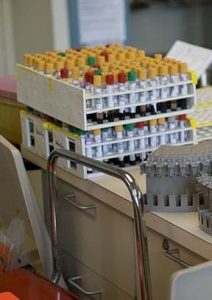Your Dog And Cat’s Albumin To Globulin Ratio – A:G Ratio
Ron Hines DVM PhD


The A:G ratio number is the amount of albumin protein in your dog or cat’s blood divided by the amount of globulin proteins in your pet’s blood. In health dogs and cats, these two proteins combined make up about 7% of their blood serum. Of that total protein, albumin comprises about 55% and globulins comprise about 35%. The largest portion of your pet’s globulins are IgG (aka antibodies). Those protein antibodies are produced by your pet’s immune system.
When too much albumin is present in your dog or cat’s blood, it is most commonly caused by dehydrated. In those cases, the globulin level will increase as well.
When too little albumin is present in your pet’s blood, it may be because it is nutritionally deprived. Or its liver may no longer be working adequately enough to produce sufficient albumin.
The amount of globulin in your pet’s blood also affects it’s A:G ratio. When tests show that the amount of specific blood globulin protein(s) in your pet are elevated, the condition is called hypergammaglobulinema. In that case, your pet’s A:G ratio will be low. In those cases, your pet’s immune system is either responding to a perceived threat (bacteria, virus, parasites, allergy or severe stress) or it is malfunctioning (a hyperplastic, precancerous or cancerous state). In this second situation, the increase above normal is most dramatic.
When too little immune globulin is present, your pet’s immune system is not working adequately to produce sufficient globulin.
Dividing your pet’s blood albumin level by its globulin level to get it’s A:G (or A/G) ratio helps alert your veterinarian to an abnormality in either albumin or globulin formation. That would be of little value if your pet’s total blood protein (TP) was not known. But because globulin levels are usually reported by simply subtracting the albumin level from the pet’s total protein level, not directly measured, it would be difficult for your vet not to already know your pet’s total protein value.
The albumin to globulin (A/G) ratio alerts your veterinarian that an abnormal situation exists. However, it is not a marker for any specific disease because it does not, in itself, tell your veterinarian which specific proteins are at abnormal levels or suggest what the cause might be. Hopefully, some of the other blood tests that were included in your dog or cat’s report will help identify the problem.
Reasons Your Pet’s A:G Ratio Might Be High:
That can occur when your pet’s blood globulin level is abnormally low. You can read about some of the possible causes for that here.
Reasons Your Pet’s A:G Ratio Might Be Low:
Your pet’s A:G ratio could be low because of low albumin (hypoalbuminemia) or high globulins (hypergammaglobulinemia). Globulins often increase in chronic inflammatory diseases of pets. In cats that could be due to feline infectious peritonitis (FIP). However, as that disease progresses, decreases in albumin due to general health decline can bring A:G ratios back closer to normal again. But despite this limitation, the A:G ratio and a high blood globulin result is still one of the few ways, baring multiple biopsies, that your veterinarian can add to a suspicion that your cat is suffering from FIP.
In dogs Ehrlichia and Leishmania infections as well as chronic colitis can cause high blood globulin levels.
Another cause of increased blood globulin in pets are globulin-secreting tumors (myelomas).
Your pet’s A:G ratio will also go down if globulin remains normal but albumin decreases – as sometimes occurs in liver disease and chronic kidney disease in dogs and cats.
Chronic intestinal inflammation in dogs and cats (protein loosing enteropathies) can also cause low blood albumin levels that influence it’s A:G ratio. In those cases, albumin leakage into the pet’s intestine exceeds any increase in globulin production that has occurred due to the chronic intestinal inflammation.
Complementary Tests:
CBC /WBC, urinalysis, blood chemistry panel (for evidence of liver enzyme abnormalities when albumin is low). Also, bile acids, cobalamin and folic acid when intestinal loss of albumin is suspected. Fecal parasite check when intestinal parasites could be the cause of low blood albumin. When A:G ratio in dogs is low and tick/flea exposure was likely, a tick panel for systemic parasites such as Ehrlichia (e.g. Idexx#2902). In cats with low A:G ratios, bartonella PCR test (e.g. Idexx#3540) particular if associated with fevers and a history of flea exposure.
When globulin is high or low, perhaps a Protein Electrophoresis and M:E ratio could be in order
DxMe
You are on the Vetspace animal health website
Visiting the products that you see displayed on this website help pay the cost of keeping these articles on the Internet.


